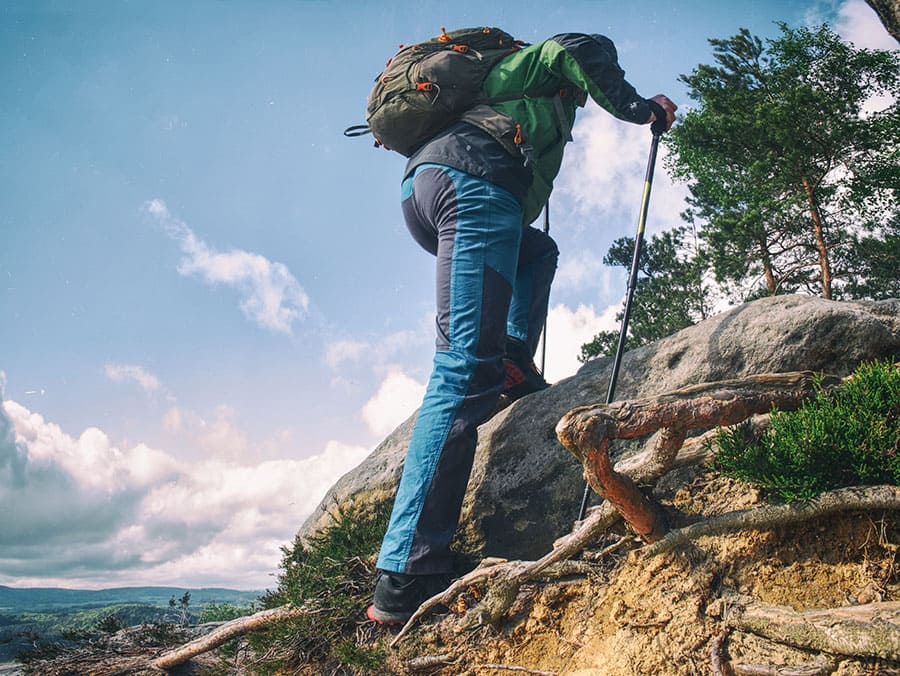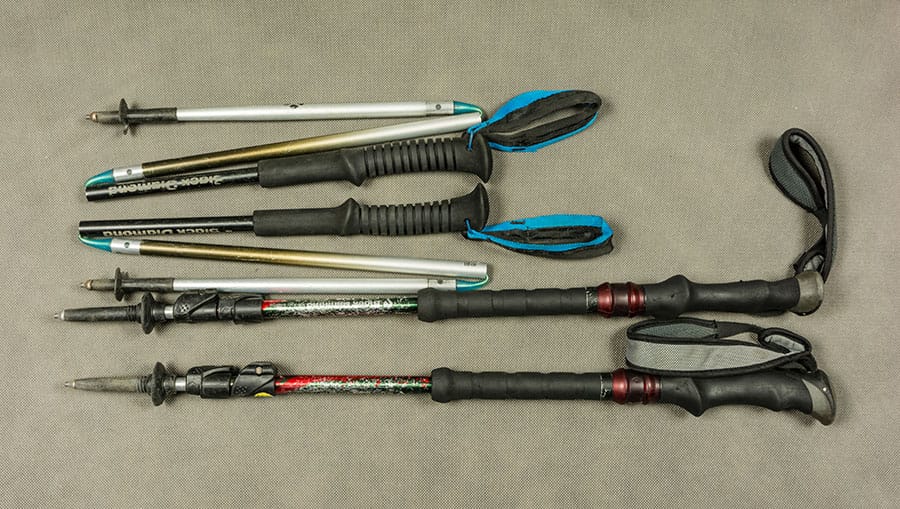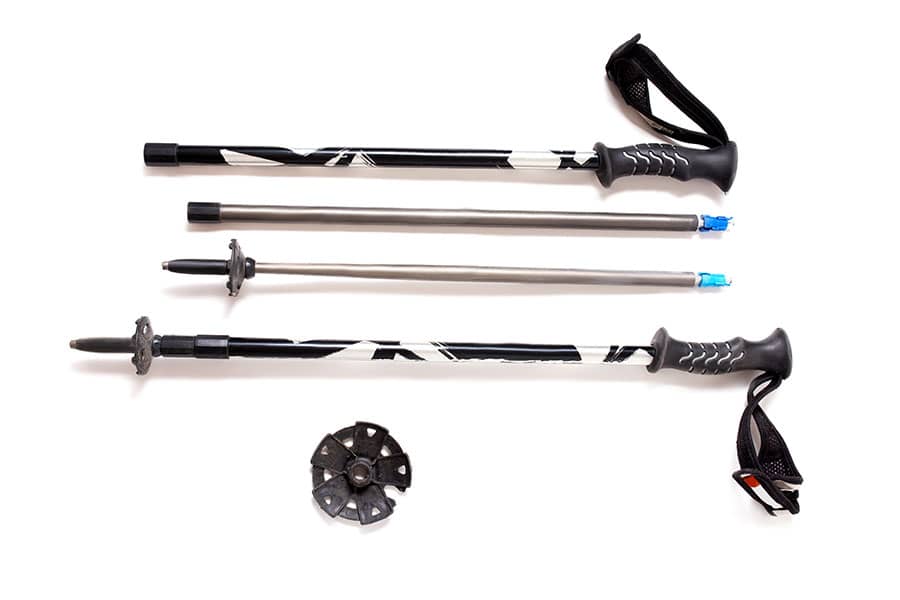Trekking poles play a crucial role in ensuring a smooth and efficient trekking adventure. Often, their significance is overlooked and individuals may hesitate to utilize them due to a lack of understanding regarding their purpose and advantages. This article aims to clarify the purpose and benefits of using trekking poles, as well as provide insights into the various components of a pole and the most effective methods for utilizing them to enhance your experience.
Advantages of Utilizing Trekking Poles
- Using this device significantly improves the ease and fluidity of walking. It also helps to enhance your balance on uneven surfaces, providing greater stability and grip. By utilizing poles in both hands, you have four points of contact with the ground, which boosts your confidence and provides additional support.
- Trekking Poles help reduce the stress and fatigue developed on the knee joints and muscles, developed during the uphill and downhill trek.
- It can come very handy is crossing streams and wading water
- Using trekking poles has been scientifically proven to engage and strengthen the muscles in your upper body, specifically the biceps and triceps, in addition to the aerobic benefits of trekking.
- Lastly, it can additionally serve the purpose of constructing shelters or providing support for your tent as a pole.

Different Types & Features of A Trekking Pole
Trekking poles come in different built types with varied features, most common types are adjustable, non-adjustable and foldable. Depending upon your usage, brand and type you select, the poles come with interesting features like shock absorbers and camera mounts. One thing to keep in mind is every additional feature comes with a weight and price added to it.
Adjustable
The height of the pole can be adjusted to enhance stability and balance in different terrains. Generally, pole length is shortened when going uphill and extended when going downhill.
Non-Adjustable
These are usually the lightest type, as the length of the pole is fixed, and it cannot be adjusted. This type of trekking pole comes handy for those people who indulge in activities that need a constant height throughout the activity.
Foldable
These are not like the adjustable poles, which slide into themselves; these function similar to that of tent poles and are best for packing light. It’s a favourite for ultra-marathon runners.

Parts of a Trekking Pole
Strap
The strap is a loop which helps you in securely holding the grip. Depending upon the brand and quality of the pole, it comes with and without padding. A strap with padding supports your wrist far better and gives you good comfort.
Grip
The handle of the trekking pole is where you hold it, and it is typically constructed from plastic, foam, rubber, or cork. There are various shapes and sizes of handles available to accommodate different hand types. It is recommended to test the handle for comfort before making a purchase. Cork and foam handles provide a better grip, especially when your hands are wet or sweating, but they are also more expensive compared to other materials. Plastic handles are the most affordable option, but they may not fully meet your needs. A handle made from a combination of cork and rubber would be a suitable choice for a trekking pole that can be used in all seasons.
Shaft
The shaft is the main part of a trekking pole and carries the most weight. Shafts are typically constructed from either aluminum or carbon composite materials. Aluminum poles are more long-lasting and cost-effective, while carbon fiber poles are pricier and extremely lightweight. However, carbon fiber poles are more prone to breaking than aluminum poles when subjected to high levels of stress.
Basket
The trekking poles typically include a compact trekking basket that can be taken off. It can be replaced with a bigger basket for traversing through deep snow or muddy ground.
Tip
This is the part that makes contact with the ground. It typically consists of a plastic body and a metal tip. The metal tips are usually made of hardened steel or carbide, both of which are harder than the rock. This allows the pole to grip onto rocks or icy patches more effectively, providing additional stability. The tips also have a detachable rubber cap that covers the sharp metal tip. This can be useful when carrying the poles in a backpack or when using them on pavements and indoors to prevent surface damage.

Locking Mechanisms of a Trekking Pole
Every trekking pole comes with a locking mechanism irrespective of whether it’s an adjustable one or not, to keep the pole from snapping its length while on a trek. However, the locking system in adjustable poles also helps in adjusting the length of the pole as per the need. Different types of locking mechanisms are internal, external, push-button and combination lock.
Internal / Twist Locking
This system uses a screw set up to expand or shorten the shaft segments. This system is comparatively stronger and durable.
External Lever Locking
This type of locking comes with an external lever like a clamp to lock the segments of shafts. When using the pole wearing gloves, this locking system comes much handy and easier.
Push Button Locking
In this mechanism, the button gets snapped in a socket and locks itself. To unlock the button needs to be pushed and the shaft segment needs to slide in or out to snap the button in the next socket. This kind of mechanism may be challenging to operate with gloves on.
Combination Locking
In this category, the pole might include a variety of locking mechanisms that enhance its strength and effectiveness. For instance, a specific pole could feature a lever lock on the upper part and a twist-lock on the lower sections of the shafts.
Right Usage of Trekking Pole
Single or Double?
Using a pair of trekking poles has been proven to be significantly more advantageous compared to using a single trekking staff (referred to as “Trekking Staff” when only one pole is used). When trekking on a fairly even surface with minimal baggage, a trekking staff can be conveniently utilized. However, it is highly recommended to employ a pair of trekking poles when navigating uneven terrain while carrying a heavy backpack.
Using The strap
The strap needs to be used properly for a comfortable trekking experience. First, adjust the loop for the hand to be put through the strap from below and bring it down to run between the thumb and the fingers and back of the hand.
Right Height
When walking on level ground, the trekking pole’s height should be adjusted so that the elbow is bent at a 90-degree angle when holding it. When ascending, decrease the height by approximately 5 to 10 centimeters, and when descending, decrease it by 5 to 10 centimeters.
Conclusion
Trekking poles are going to be useful and handy gear which can make your trekking trip more comfortable. Choosing the right one hugely depends on your budget and usage.




